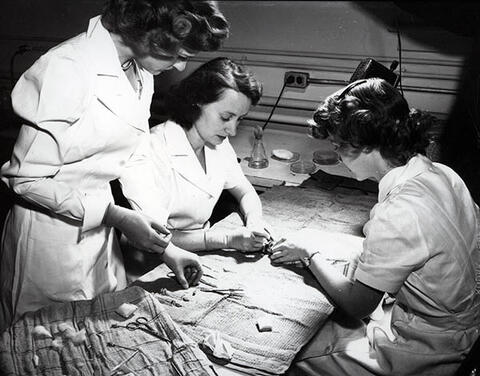
Zona do título e menção de responsabilidade
Título próprio
Dr. Althea N. Burton, I. Wynn and [Helen] Rublee - Encephalomyelitis Research
Designação geral do material
- Material gráfico
Título paralelo
Outra informação do título
Título e menções de responsabilidade
Notas ao título
Nível de descrição
Item
Entidade detentora
Código de referência
Zona de edição
Menção de edição
Menção de responsabilidade da edição
Zona de detalhes específicos de materiais
Menção da escala (cartográfica)
Menção da projecção (cartográfica)
Menção das coordenadas (cartográfico)
Menção da escala (arquitectura)
Autoridade emissora e denominação (filatélica)
Zona de datas de criação
Data(s)
-
Apr. 1948 (Produção)
Zona de descrição física
Descrição física
1 photograph : b&w ; 9 x 12 cm
Zona dos editores das publicações
Título próprio do recurso continuado
Títulos paralelos das publicações do editor
Outra informação do título das publicações do editor
Menção de responsabilidade relativa ao editor do recurso contínuo
Numeração das publicações do editor
Nota sobre as publicações do editor
Zona da descrição do arquivo
Nome do produtor
História custodial
Âmbito e conteúdo
Dr. Althea N. Burton (centre), veterinary surgeon, working with I. Wynn (at Dr. Burton’s left) and [Helen]. Rublee (right), laboratory technicians, to transfer a virus to a live guinea pig.
Bio/Historical Note from news clipping: “Part of the technique of producing vaccine for encephalomyelitis or “sleeping sickness” in horses is shown here. Dr. Althea N. Burton (second from left), veterinary surgeon at the university’s animal diseases laboratory, is transferring a deadly virus obtained from the brain of a dead guinea pig to that of a live one. The animal’s skull has been anaesthetized and it feels no pain, and will die within four days. Laboratory technicians like I. Wynn (at Dr. Burton’s left) and H. Rublee (right), will remove the brain and place it in a glycerine preservative, keeping it there for a maximum of two weeks. The brain is then ground up and placed in a solution which is injected into an 11-day chicken embryo. Mamie C. Janzen (see A- 3643), is shown in this operation at far right. The egg shell is sealed with wax and incubated a further 24 hours, the length of time for the virus to kill the embryo. Removed from the shell and ground up in a “colloid mill”, formalin is added to the embryo to kill the virus. The vaccine is then filtered, diluted in saline solution, and stored for two weeks to ensure the death of the entire virus. In this form it is bottled and shipped to prairie druggist[s] from whom farmers buy it and inoculate their horses at a total cost of $1 per horse.” From Saskatoon Star-Phoenix, Apr. 1948.
Bio/Historical Note: In the mid-1940s Dr. J.S. Fulton and his research colleague, Dr. Althea N. Burton, modified the Western Equine Encephalitis Vaccine (WEE) so it could be used in humans. Burton initially worked as a technician in Fulton’s lab before completing her veterinary degree at the Ontario Veterinary College in 1947. After Fulton’s retirement in 1958, Burton continued the WEE studies in collaboration with other Saskatoon scientists — including professional and amateur entomologists. This collaborative team eventually confirmed that the WEE virus overwintered on the Prairies and was transmitted to birds, horses and humans through mosquito species. In 1966 the United States government granted $95,000 to a research team at the U of S for studies of western encephalitis. The grant, spread over three years, was made for research by Dr. Jacob G. Rempel, professor of Biology, and by Dr. Burton. Although research into the disease had been underway in Saskatchewan since the 1930s, the work was intensified with the announcement of the South Saskatchewan River Project and the Saskatoon team has produced results sufficiently impressive to attract international attention. More than 40 years later, findings from those foundational studies in WEE became invaluable as public health teams in Western Canada learned to deal with the spread of West Nile virus — another mosquito-borne arbovirus that affects birds, horses and humans.
Zona das notas
Condição física
Fonte imediata de aquisição
Organização
Idioma do material
Script do material
Localização de originais
Disponibilidade de outros formatos
Restrições de acesso
Termos que regulam o uso, reprodução e publicação
Photographer: Saskatoon Star-Phoenix
Copyright: University of Saskatchewan
Instrumentos de descrição
Materiais associados
Ingressos adicionais
Nota geral
See A-3643 for second image of series.

